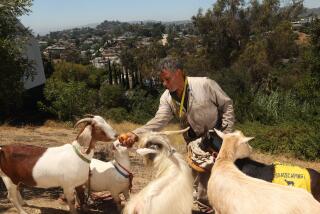Goat Rescue Resumes on San Clemente Island
- Share via
A helicopter team sponsored by an animal rights organization resumed efforts Friday to rescue several hundred wild goats from San Clemente Island, plucking 12 of them from the rugged terrain before darkness fell.
Cleveland Amory, author and head of the Fund for Animals, said that the operation is taking up where it left off in February when 870 of an estimated 1,200 to 1,500 goats were captured and returned to the mainland.
San Clemente Island, about 60 miles west of San Diego, is owned by the Navy and used for bombing and shelling practice. The goats are believed to be descendants of domestic goats put on the island 200 years ago by passing seamen.
Amory said Friday night that the day’s rescue effort got off to a late start because participants had to be briefed by Navy officials on the probable location of unexploded ordnance on the island.
About 700 Goats Remaining
Further rescue efforts are planned for today, Amory said, adding, “They’ll start earlier . . . and work longer.
“We think there are between 500 and 700 (goats) left out there,” Amory said in an interview earlier in the day. “It is our hope that we can get them all this time. The Navy has given us through July 26 to work at it. Almost all the ones we rescued before have been adopted by private citizens.”
Earlier this year, the Navy had planned to shoot the goats because scientists claimed that the animals were destroying several species of island plants, birds and animals that appear on the federal endangered species list. The shooting was called off just hours before it was scheduled to start when Secretary of Defense Caspar W. Weinberger responded to pleas from Amory’s group.
Amory said he was encouraged by the fact that, in a departure from past practice, the Navy is allowing the rescue team to operate in the shore bombardment zones of the island. There is no bombardment scheduled this month, but the area is believed to be littered with unexploded shells.
‘A Dangerous Operation’
Navy spokesman Ken Mitchell said he still thinks “it’s a dangerous operation,” but that the Fund for Animals had signed an agreement taking full responsibility for any mishaps.
Furthermore, the rescue crew, including helicopter pilot Mel Cain, of San Diego, and Bill Hales, of New Zealand, were given a careful briefing on the location of unexploded ordnance.
The copter crew captures the goats by firing a net over them from low altitude.
“Then Bill Hales jumps to the ground and gathers them up,” Amory said. “He’s the only one who touches the ground during the operation, and he’s too smart to take foolish chances.
“It isn’t going to be fun out there,” Amory said. “At the briefing, the Navy experts said small stuff, the size of hand grenades, can kill up to 50 feet, and some of the larger stuff, although fitted with safety devices, can kill anything within a mile if the safety catch has rusted through.”
More to Read
Sign up for Essential California
The most important California stories and recommendations in your inbox every morning.
You may occasionally receive promotional content from the Los Angeles Times.













